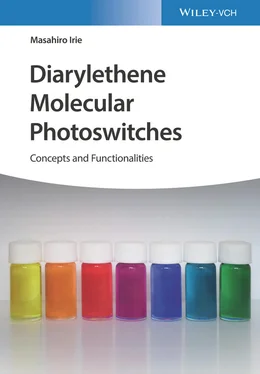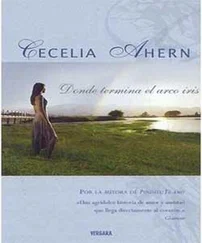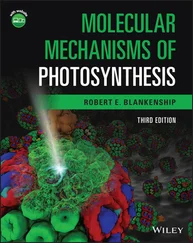1 Cover
2 Title Page Diarylethene Molecular Photoswitches Concepts and Functionalities Masahiro Irie
3 Copyright Author Masahiro Irie Professor emeritus Kyushu University Japan All books published by Wiley‐VCH are carefully produced. Nevertheless, authors, editors, and publisher do not warrant the information contained in these books, including this book, to be free of errors. Readers are advised to keep in mind that statements, data, illustrations, procedural details or other items may inadvertently be inaccurate. Library of Congress Card No.: applied for British Library Cataloguing‐in‐Publication Data A catalogue record for this book is available from the British Library. Bibliographic information published by the Deutsche Nationalbibliothek The Deutsche Nationalbibliothek lists this publication in the Deutsche Nationalbibliografie; detailed bibliographic data are available on the Internet at < http://dnb.d-nb.de >. © 2021 WILEY‐VCH GmbH, Boschstr. 12, 69469 Weinheim, Germany All rights reserved (including those of translation into other languages). No part of this book may be reproduced in any form – by photoprinting, microfilm, or any other means – nor transmitted or translated into a machine language without written permission from the publishers. Registered names, trademarks, etc. used in this book, even when not specifically marked as such, are not to be considered unprotected by law. Print ISBN: 978‐3‐527‐34640‐0 ePDF ISBN: 978‐3‐527‐34642‐4 ePub ISBN: 978‐3‐527‐82286‐7 oBook ISBN: 978‐3‐527‐82285‐0 LC record available at https://lccn.loc.gov/2020033403 LC ebook record available at https://lccn.loc.gov/2020033404
4 Preface
5 1 Introduction1.1 General Introduction 1.2 Discovery of Diarylethene Molecular Photoswitches References
6 2 Reaction Mechanism 2.1 Basic Concepts 2.2 Theoretical Study2.3 Reaction Dynamics References
7 3 Photoswitching Performance3.1 Quantum Yield 3.2 Thermal Stability 3.3 Fatigue Resistance 3.4 Fluorescence Property 3.5 Chiral Property References
8 4 Photoswitchable Crystals 4.1 Dichroism 4.2 X‐Ray Crystallographic Analysis 4.3 Quantum Yield 4.4 Multicolored Systems and Nano‐Layered Periodic Structures 4.5 Fluorescent Crystals 4.6 Photomechanical Response References
9 5 Memory 5.1 Single‐Molecule Memory 5.2 Near‐Field Optical Memory 5.3 Three‐Dimensional Optical Memory 5.4 Readout Using Infrared Absorption, Raman Scattering, and Refractive Index Changes References
10 6 Switches 6.1 Single‐Molecule Conductance Photoswitch 6.2 Optical Switch Based on Refractive Index Change 6.3 Magnetism References
11 7 Surface Properties7.1 Surface Wettability 7.2 Selective Metal Deposition 7.3 Subwavelength Nanopatterning References
12 8 Polymers and Liquid Crystals 8.1 Polymers 8.2 Liquid Crystals References
13 9 Applications9.1 Organic Field‐Effect Transistors (OFETs) 9.2 Metal Organic Frameworks (MOFs) 9.3 Super‐Resolution Fluorescence Microscopy 9.4 Chemical Reactivity Control 9.5 Biological Activity 9.6 Color Dosimeters References
14 Appendix A: Appendix ASynthesis Procedures of Typical Diarylethenes A.1 1,2‐Bis(2,4‐dimethyl‐5‐phenyl‐3‐thienyl)perfluorocyclopentene (7) [5–7] A.2 1,2‐Bis(2‐ethyl‐6‐phenyl‐1‐benzothiophene‐1,1‐ dioxide‐3‐yl)‐perfluorocyclopenetene (11) [8–10] References
15 Index
16 End User License Agreement
1 Chapter 2 Table 2.1 Relative ground state energy differences between the open‐ and clos... Table 2.2 Aromatic stabilization energy differences.
2 Chapter 3 Table 3.1 Photocyclization and photocycloreversion quantum yields of typical ... Table 3.2 Ratios of antiparallel and parallel conformers and photocyclization...Table 3.3 Photocyclization and photocycloreversion quantum yields of bisarylb...Table 3.4 Photocyclization and photocycloreversion quantum yields of diarylet...Table 3.5 Photocyclization and photocycloreversion quantum yields of diarylet...Table 3.6 Photocyclization and photocycloreversion quantum yields of diarylet...Table 3.7 T‐type molecular photoswitches. Half‐life times of closed‐ring isom...Table 3.8 Photochemical properties of diarylethenes in acetonitrile upon irra...Table 3.9 Photophysical properties of fluorescent diarylethenes ( λ max: a...Table 3.10 Photophysical and photochemical properties of 123, 8, and 138– 142....
3 Chapter 4Table 4.1 Photocyclization and photocycloreversion quantum yields in n ‐hexane ...
4 Chapter 6Table 6.1 Magnetic interactions between two nitronyl nitroxide radicals in di...
5 Chapter 8Table 8.1 Examples of polymers having diarylethene units in the main chain.Table 8.2 Examples of polymers having diarylethene units in the side groups.
6 Chapter 9Table 9.1 Photophysical and photochemical properties of turn‐on mode fluoresc...Table 9.2 Photochemical and photophysical properties of 8.Table 9.3 Radiation‐induced coloration of diarylethene 3in solutions and soli...
1 Chapter 1 Figure 1.1 The use of light in biological systems. Scheme 1.1 Molecular photoswitches and years when they were discovered. Figure 1.2 Schematic illustration of the photoinduced conformational change ... Figure 1.3 A synthesis route of poly(2,3‐diphenylbutadiene) and its photoche... Figure 1.4 (A) Synthesis of polymers having (a) 2,3‐dimesitylbutene units an... Figure 1.5 Development of diarylethene molecular photoswitches. Figure 1.6 Color changes of diarylethene derivatives 1–7in toluene up... Figure 1.7 Chemical structures and absorption spectra of open‐ and closed‐ri... Figure 1.8 (a) Chemical structures of open‐ and closed‐ring isomers of 8. (b...
2 Chapter 2 Scheme 2.1 Electrocyclic reactions of diarylethenes 9− 12. Scheme 2.2 Disrotatory and conrotatory cyclization reactions of hexatriene.... Figure 2.1 State correlation diagrams for the electrocyclic reactions in dis... Figure 2.2 State correlation diagrams for the electrocyclic reactions in con... Figure 2.3 Correlation between the ground state energy difference between op... Scheme 2.3 The structure changes of phenyl and five‐membered heterocyclic ri... Figure 2.4 Thermal stability of diarylethene derivatives. Any appreciable ch... Figure 2.5 Potential energy surfaces of a model diarylethene. Figure 2.6 Potential energy surfaces of ground (1A) and two excited (2A and ... Figure 2.7 Schematic representation of the structures of S 0(orange) and S 1... Figure 2.8 Outline of two reaction paths corresponding to ring‐opening and r... Scheme 2.4 A diarylethene open‐ring isomer has two conformations with two ar... Figure 2.9 Transient absorption spectra of 5during the ring‐closing reactio... Figure 2.10 Transient absorption spectra of 5during the ring‐closing reacti... Figure 2.11 Time profiles of transient absorbance of 13in n ‐hexane excited ... Figure 2.12 Time‐resolved transient absorption spectra of 20cin n ‐hexane ex...
3 Chapter 3 Figure 3.1 1H NMR methyl signals of (a) 5oand (b) 13oin CDCl 3.Scheme 3.1 A diarylethene derivative having a benzobis(thiadiazole) bridge. ...Figure 3.2 (a) Chemical structures of open‐ and close‐ring isomers of 64. (b...Figure 3.3 Schematic illustration of the solvent effect on the photocyclizat...Figure 3.4 Photoirradiation wavelength dependence of the cycloreversion quan...Figure 3.5 (a) Quantum yields for the ring‐opening reaction of
Читать дальше












